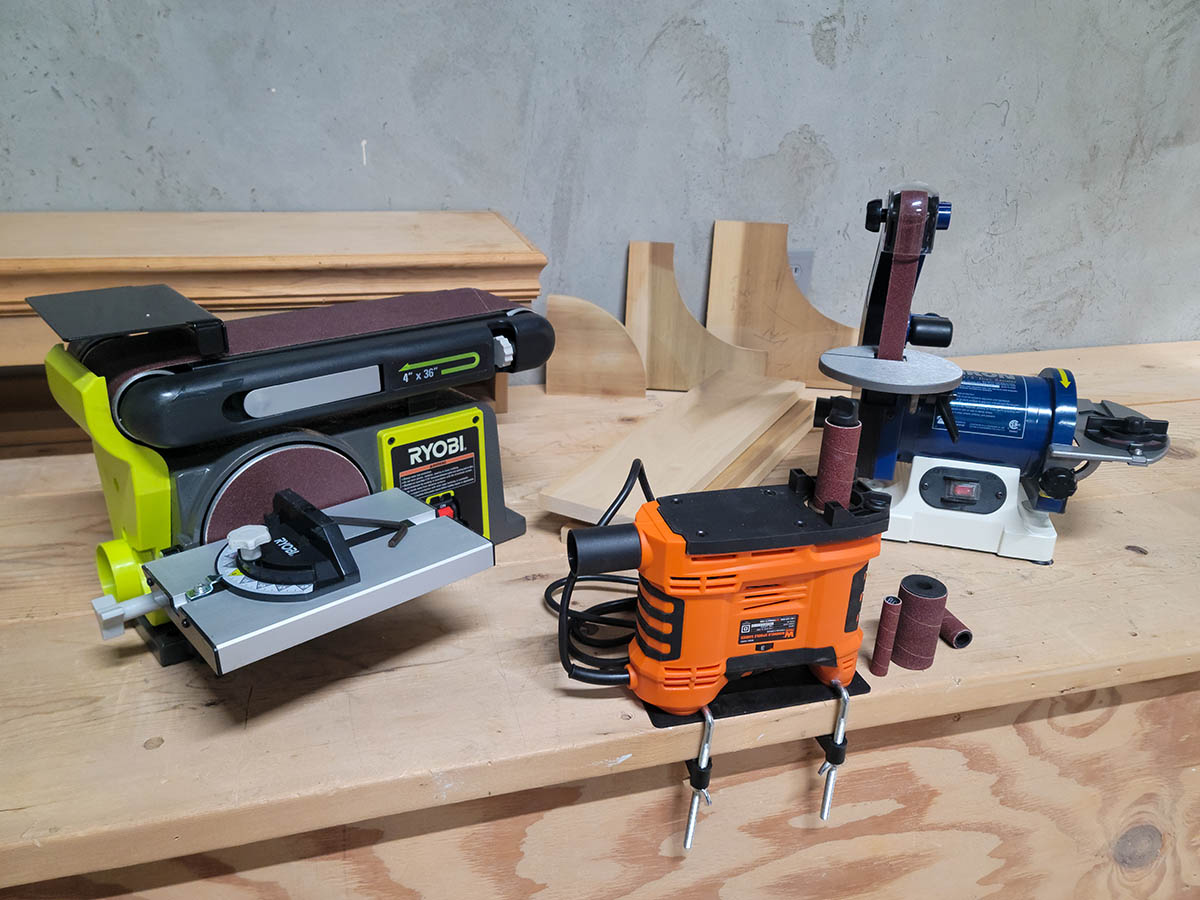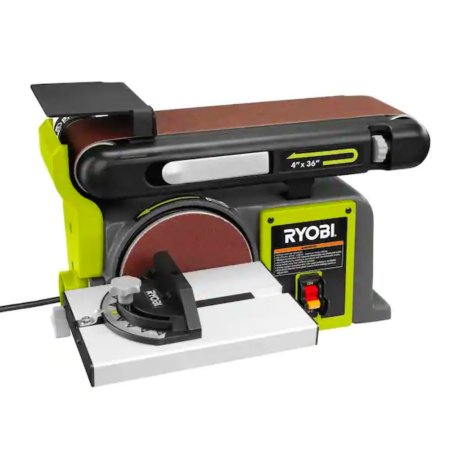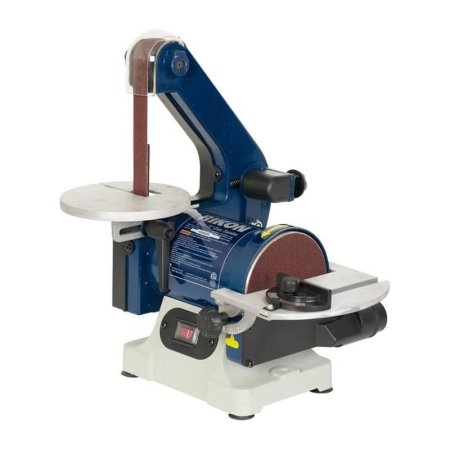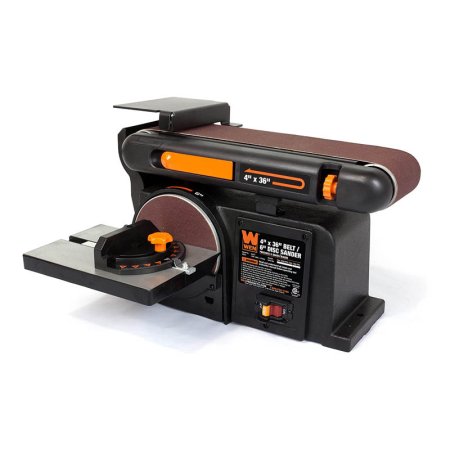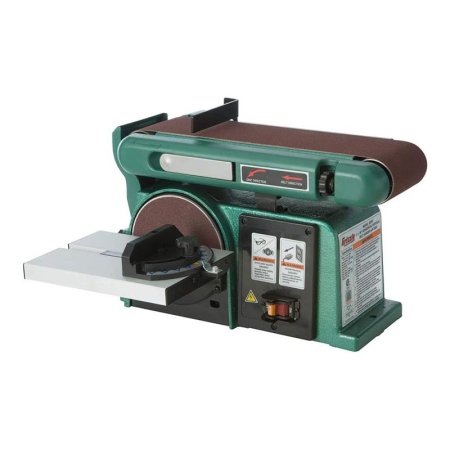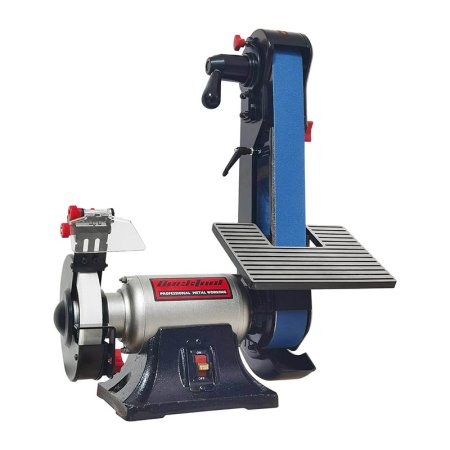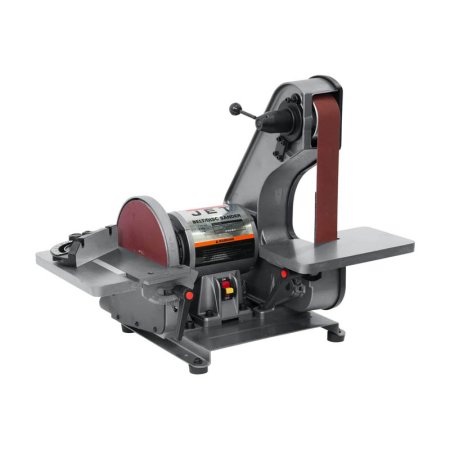We may earn revenue from the products available on this page and participate in affiliate programs. Learn More ›
Best Overall
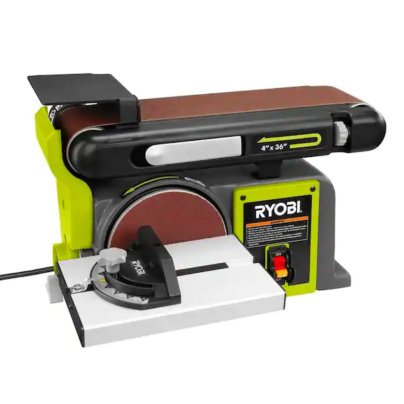
Ryobi BD4601G 4-Inch by 36-Inch Belt/Disc Sander
Best Bang for the Buck
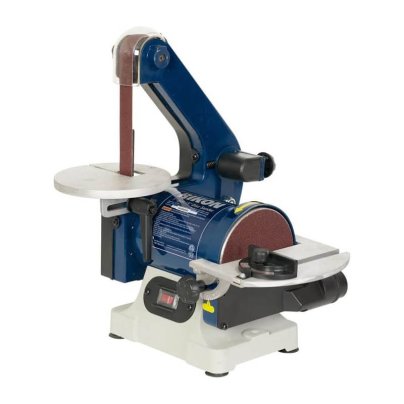
Rikon Power Tools 50-151 Bench Sander
Best for Large Tasks
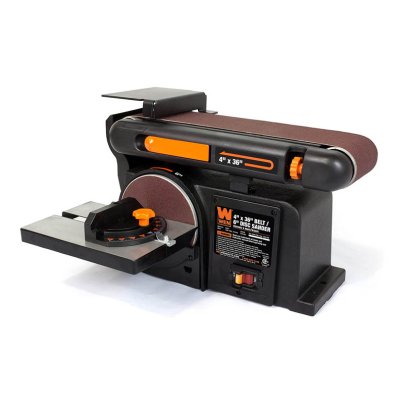
Wen 6502T 4-Inch by 36-Inch Belt and Disc Sander
Bench sanders are designed to smooth large surfaces quickly and easily, allowing you to finish a woodworking project faster. We researched more than 20 best-selling bench sanders and then tested the top five to see how well they performed in workshop sanding situations. And we found a favorite: the Ryobi BD4601G 4-Inch by 36-Inch Belt/Disc Sander, which offers a large flat sanding surface plus a 6-inch sanding disc. It excelled in our hands-on sanding tests.
If the Ryobi isn’t the right tool for you, no need to worry—we tested more top-rated models that provide additional sanding solutions for DIYers and pros. We also added three more models to our list, which, though we didn’t test them, grabbed our attention based on reviews and customer ratings. Among our lineup of the best bench sanders, you’ll find combo models and even a sander that comes with a grinding wheel.
- BEST OVERALL: Ryobi BD4601G 4-Inch by 36-Inch Belt/Disc Sander
↓ Jump to Review - BEST BANG FOR THE BUCK: Rikon Power Tools 50-151 Bench Sander
↓ Jump to Review - BEST FOR LARGE TASKS: Wen 6502T 4-Inch by 36-Inch Belt and Disc Sander
↓ Jump to Review - BEST UPGRADE PICK: Grizzly Industrial G0787 Horizontal/Vertical Belt Sander
↓ Jump to Review - BEST VERTICAL: Bucktool BG2600 Combo Belt Sander Bench Grinder
↓ Jump to Review - BEST FOR SHOP: Jet J-41002 Belt Grinder and Disc Sander
↓ Jump to Review - BEST COMBO SANDER: Rockwell RK7866 Shop Series Belt/Disc Combo Sander
↓ Jump to Review
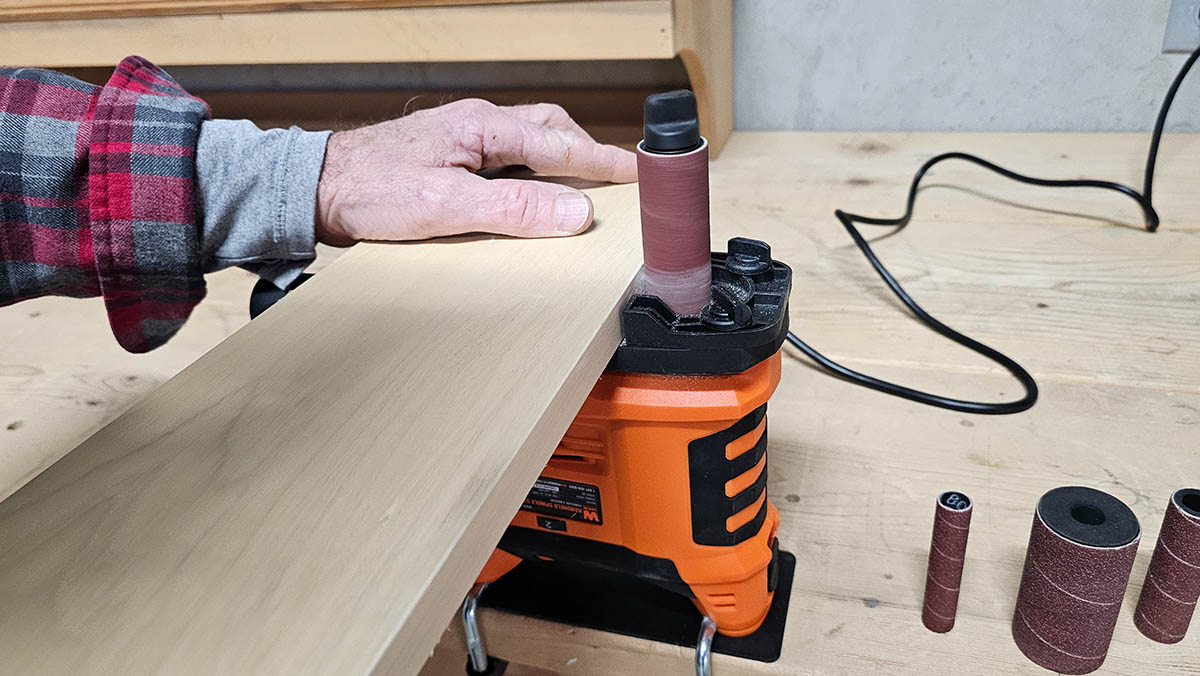
Bench Sanders Comparison Chart
| Product | Type | Power | Dust Port? |
| Ryobi BD4601G Belt/Disc Sander | Belt and disc | 4.3 amps | Yes |
| Rikon 50-151 Bench Sander | Belt and disc | 0.33 hp | Yes |
| Wen 6502T Belt/Disc Sander | Belt and disc | ½ hp | Yes |
| Grizzly Industrial G0787 Sander | Belt and disc | 4.3 amps, ½ hp | Yes |
| Bucktool BG2600 Combo Sander | Belt and grinder | 3.5 amps | Yes |
| Jet J-41002 Belt/Disc Sander | Belt and disc | 6.2 amps, ¾ hp | Yes |
| Rockwell RK7866 Belt/Disc Sander | Belt and disc | 4.3 amps | Yes |

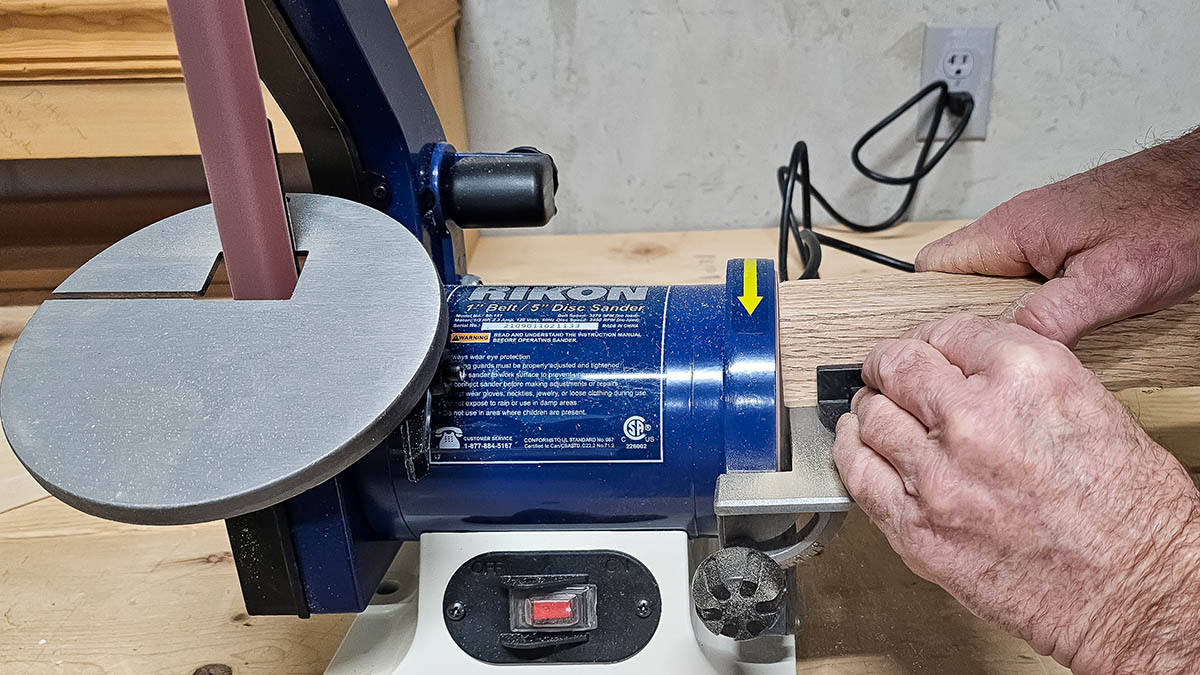
Our Top Picks
The following list of bench sanders has something for every woodworker. We chose models with wide belts for aggressive wood removal and some with narrow belts for finer detail work. Many include rotating discs and fences or miter gauges for precision work, and we’ve included high-quality models to fit various budgets. One is sure to be a good pick for your workshop.
Best Overall
Ryobi BD4601G 4-Inch by 36-Inch Belt/Disc Sander
What We Like
- Wide-profile belt for large sanding tasks
- Belt and disc sanding options
- Integrated dust port
- Miter gauge for sanding angles
What We Don’t Like
- Dust collection requires attaching a hose
Specs
- Type: Belt and disc sander
- Power: 4.3 amps
- Additional accessories: Integrated dust port, work table
Our Ratings: Ease of Use 4.8/5; Build Quality 5/5; Performance 5/5; Value 4.8/5
This pick can get a lot of sanding done in a hurry thanks to its 36-inch by 4-inch belt and the driving force of the powerful 4.3-amp motor. This impressive tabletop belt sander also has a 6-inch disc and an adjustable tool rest table that we used to smooth bevels and angles.
We especially liked its adjustable belt position, which allowed us to use the sander vertically or horizontally. That’s a definite perk when sanding various board configurations for the same project.
The integrated dust port on this benchtop sander can be connected to a collection bag or to a shop-type vacuum. We used it with and without an attached vacuum hose, and it significantly reduced the amount of airborne dust. The sanding disc table has a miter gauge to support material at a specific angle, and we found that very helpful for sanding consistent angles.
What our tester says: “I love how stable the Ryobi bench sander is. I tested it with and without it being bolted to the workbench, and although I’d always suggest bolting, the Ryobi didn’t walk or move when it wasn’t bolted.” —Glenda Taylor, Product Reviews tester and writer
Get the Ryobi bench sander at Amazon, The Home Depot or Walmart.
Best Bang for the Buck
Rikon Power Tools 50-151 Bench Sander
What We Like
- Budget-friendly price
- Compact size for small-scale DIY
- Sturdy tool rest table
- Built-in miter gauge
What We Don’t Like
- Not suitable for heavy-duty sanding
Specs
- Type: Belt and disc sander
- Power: 0.33 hp
- Additional accessories: Dust port, miter gauge
Our Ratings: Ease of Use 4.5/5; Build Quality 4/5; Performance 5/5; Value 5/5
With the Rikon 50-151 bench sander, users can enjoy the power of a bench sander without spending a lot of money. It features a narrow 1-inch by 30-inch sanding belt that performed well in our tests for smaller projects. It has a sturdy tool rest table that supported our workpieces while we sanded.
The Rikon also features a disc sander with a built-in miter gauge, which we used to sand consistent angles and square ends on both hardwood and softwood boards.
This is a light-duty sander, and we’d recommend it for small DIY and craft projects or repair work. It’s not big enough or powerful enough to handle large sanding projects, but it’s well worth the investment for those who work on many small-scale projects. We connected our shop vacuum to the dust port, which reduced airborne dust, but enough escaped that wearing a dust mask is a must.
Get the Rikon bench sander at Amazon or Walmart.
Best for Large Tasks
Wen 6502T 4-Inch by 36-Inch Belt and Disc Sander
What We Like
- Belt and disc sanding combo
- Quickly smooths rough wood
- Quick and easy sandpaper changes
- Smooth operation (no wobbling)
What We Don’t Like
- Requires vacuum for dust mitigation
Specs
- Type: Belt and disc sander
- Power: 4.3 amps
- Additional accessories: Miter gauge, dust port
Our Ratings: Ease of Use 4.5/5; Build Quality 5/5; Performance 5/5; Value 4.5/5
This Wen bench sander comes with two standard sanding tools—a 4-inch belt sander and a 6-inch disc sander—so it can handle a range of projects. It has a cast-iron base and weighs 37.6 pounds, which is heavy enough to prevent most wobbling during use, but we bolted it to our workbench anyway.
In our tests, the sanding belt did an excellent job of quickly smoothing out rough wood surfaces and removing extra material on both hardwood and softwood boards. The 6-inch disc features a large tool rest table and built-in miter gauge that we used to sand square board ends and angled ends.
The Wen bench sander is powered by a 4.3-amp motor and has a simple tension release lever for changing the sandpaper. The sanding belts on this sander are also designed for easy replacement. Its dust collection port doesn’t direct the flow of sawdust on its own, but when we connected it to our shop vacuum, it substantially reduced the amount of airborne dust.
Get the Wen 6502T bench sander at Amazon or The Home Depot.
Best Upgrade Pick
Grizzly Industrial G0787 Horizontal/Vertical Belt Sander
What We Like
- Multipurpose shop tool for sanding and grinding
- Lower risk of damage from heat buildup
- Sharpens material quickly
- Easy to adjust/change grit
What We Don’t Like
- 80-grit belt is not aggressive
- Requires practice to achieve precision
Specs
- Type: Belt grinder and sander
- Power: 4.3 amps, ½ hp
- Additional accessories: Built-in adjustable miter gauge, 2½-inch dust port, worktable angle scale
Our Ratings: Ease of Use 4/5; Build Quality 4.5/5; Performance 4/5; Value 5/5
The Grizzly Industrial horizontal/vertical belt sander works well on wood or metal projects, and we tested this one for sharpening mower blades. It packs a 4.3-amp single-phase motor that turns the belt at a rate of 1,900 feet per minute. The 90-degree adjustable belt platen and right-angle backstop allow vertical, diagonal, or horizontal sanding for optimal user comfort and control.
The 4-inch abrasive belt perfectly matched the width of the sharp edges on our 21.5-inch mower blades. We raised the belt arm to the vertical position, flipped the power switch, and braced the blade against the backstop as it contacted the belt. The moderately worn blade only needed a 12-second grind on each edge, while the severely worn blade required 27 seconds per edge. This would also be a good bench sander for large woodworking projects.
What our tester says: “I liked that the Grizzly belt sander gave the edge an evenly flat profile, and the included 80-grit belt left a smooth finish.” —Mark Wolfe, Product Reviews tester & writer
Get the Grizzly Industrial bench sander at Amazon, Tractor Supply Co., The Home Depot, or Grizzly Industrial.
More Great Options
While we didn’t test the following models in our workshops, they made our shortlist of bench grinders based on their standout reviews and ratings. Each offers a slightly different range of power and features in a range of budgets.
Best Vertical
Bucktool BG2600 Combo Belt Sander Bench Grinder
What We Like
- 42-inch belt adjusts from 0 to 90 degrees
- Horizontal and vertical sanding
- Brush wheel included
What We Don’t Like
- Bench sanding belt’s tension cannot be adjusted
Specs
- Type: Belt sander and disc grinder
- Power: 3.5 amps
- Additional accessories: Cast-iron base, eye shield, brass wheel
This Bucktool bench sander has a 2-inch by 42-inch belt sander that can be adjusted from 0 degrees to 90 degrees, so it can be set up to run horizontally or vertically, depending on needs. We really like the 6-inch bench grinder that can be used for sharpening, as well as the inclusion of a brush wheel for removing rust from tools.
This combination belt sander/bench grinder has a 3.5-amp motor and a cast-iron base for better support while working. For the most stable sanding results, we still recommend bolting the Bucktool to a workbench. The grinder also comes with an adjustable eye shield and a built-in LED light, which illuminates the work area while the wheel is in use.
This is one of the most versatile picks on our list because it sands, grinds, and brushes away rust.
Get the Bucktool bench sander at Amazon.
Best for Shop
Jet J-41002 Belt Grinder and Disc Sander
What We Like
- Suitable for multiple sanding tasks
- 3,100 surface feet per minute (SFPM)
- 3,450 revolutions per minute (RPM)
- Made of heavy-duty steel and cast iron
What We Don’t Like
- Heavy: may not be suitable for frequent transport
Specs
- Type: Belt grinder and disc sander
- Power: 6.2 amps, ¾ hp
- Additional accessories: 45-degree sanding table, miter gauge
Woodworkers in search of a highly functional combination belt and disc sander may want to check out this Jet model, which has a powerful 6.2-amp motor, one of the most powerful of any on our lineup. It drives the vertical 42-inch-long by 2-inch-wide belt sander at up to 3,100 SFPM and the 8-inch disc sander at up to 3,450 RPM, helping to ensure a smooth finish on woodworking projects.
The powerful motor and the heavy-duty steel and cast-iron construction add to the weight of this benchtop belt sander, sitting at a hefty 60 pounds, so it may not be a good choice for users who want to pack it up and take it to multiple jobsites. However, the 45-degree sanding table has a removable miter gauge to help users produce a smooth, accurate finish while sanding at an angle.
The only thing we would prefer on this model is a wider sanding belt. With the power this sander has, a 4-inch belt would make quick work of sanding large projects.
Get the Jet bench sander at Amazon, The Home Depot, or Walmart.
Best Combo Sander
Rockwell RK7866 Shop Series Belt/Disc Combo Sander
What We Like
- 6-inch disc sander
- Table adjusts from 0 to 45 degrees
- Offers horizontal and vertical sanding
- Built-in safety switch
- Dust collection port
What We Don’t Like
- Some users report poor construction
- Belt tends to strip out easily
Specs
- Type: Belt and disc sander
- Power: 4.3 amps, ½ hp
- Additional accessories: Adjustable table, dust port
This Rockwell belt/disc combo sander can get a lot of work done fast thanks to its wide belt sander and 4.3-amp (½ hp) motor. We like that it also has a 6-inch disc sander and an adjustable sanding table that can be set from 0 to 45 degrees for optimal material positioning. This belt sander can be adjusted from a horizontal position to a vertical sanding position.
The Rockwell has a safety switch to prevent accidental starts. For convenience, both the belt and disc sandpaper are easy to change. The Rockwell sander also comes with a dust collection system. It weighs 42 pounds, which we feel is heavy enough to reduce most of the vibration or movement associated with sanding, but we still recommend bolting it in a permanent spot on the workbench.
Get the Rockwell bench sander at Amazon, Lowe’s, or The Home Depot.
Jump to Our Top Picks
How We Chose and Tested the Best Bench Sanders
| Testing Stats | |
|---|---|
| Products tested | 5 |
| Time spent testing | 2 weeks |
| Tests performed | 4 |
| Price range | $60 to $350 |
We started by researching the best-selling bench sanders based on type, power, user-friendliness, and other special features included by top brands. We narrowed our list to eight and then selected the top five for hands-on testing. (We also tested the Wen HA5932 Portable Oscillating Spindle Sander, but went out of stock upon publication.)
In actual testing, we used the bench sanders in our workshops to perform various sanding tasks. We sanded hardwood and softwood, and we used the miter gauges available on some models to sand square ends and angles. We carefully noted the safety aspects of each of the sanders as well as beneficial features that made using the tools easier or more efficient.
We awarded points based on a rubric: the better a bench sander performed on a test or assessment, the higher the points. After testing, we averaged the points to determine our best overall pick and to categorize the other bench sanders by their best use.
What to Consider When Choosing a Bench Sander
There is a lot to consider when searching for the right sander. From the space available to the particular type of machine best suited to your needs, the following are some things to think about when looking for the best benchtop sanders for a workshop.
Type
Many different types of electrical sanders fall under the category of bench sander, giving tool users a range of options for their woodworking projects. Bench sander types include belt and disc, drum, and oscillating spindle sanders.
- A belt and disc sander is a combination bench sander that includes a horizontal or vertical belt sander and a disc sander. The benchtop belt sander is a great choice for DIYers who enjoy woodworking projects because it provides multiple methods for sanding, smoothing, and shaping woodworking pieces.
- Drum sanders have traditionally been large freestanding tools with impressive power, but recently manufacturers have started producing a type of benchtop drum sander that can sit on the worktable or workbench. Drum sanders are designed to smooth long boards, panels, or doors and are essentially large stationary belt sanders.
- Oscillating spindle sanders have a vertical spindle where the abrasive sleeves are installed. This spindle rotates and oscillates up and down simultaneously, helping to prevent any lines from forming in the wood or alternate material. The result is a smooth finish on curves, contours, and other irregular shapes.
Power
The amount of power a bench sander needs depends on how it will be used. Large projects benefit from a sander with a powerful motor that can rip through a lot of material in a short period of time. Smaller, delicate projects need a less powerful sander, as too much force can ruin a design or tear the material apart.
Additionally, a powerful sander is harder to control, which is not ideal when working with a small piece of wood. A bench sander with a ⅓ to ¾ hp motor—or about 1 to 5 amps—should be sufficient for most DIY sanding projects.
Adjustability
The best bench sanders for woodworking can be adjusted to customize motor speed, sanding angle, and sanding surface, which gives the tool the ability to handle a wider range of projects and materials. A bench sander with speed controls lets users throttle its power output.
The sanding angle on some belt sanders can be adjusted horizontally or vertically. There are also bench sanders that can be set to use a range of sandpaper types for smoothing materials other than wood.
Ease of Use
If the goal is to find a tool that’s easy to use, look for a sander with intuitive controls, clearly indicated measurements, and clear instructions for use. A bench sander needs to be heavy enough to remain steady as wood is pushed against it but light enough to move around as needed in the workshop. A tool in the weight range of 30 to 40 pounds is usually ideal. Even with sufficient heft, it’s helpful for a sander to have a nonslip base so that it remains stable on the workbench during use.
Make sure to choose the right kind of bench sander for the work that’s planned. For fine work, a bench sander with a spindle-sanding tool is the best bet. If a wide range of projects are planned, a sander with a belt sanding tool, disc sanders, or a grinding wheel may be the better choice.
Additional Features
Bench sanders can come with several different accessories or built-in features to help make it easier to control the sander and achieve the best finish possible on projects. Remember that these tools can be loud, so have hearing protection on hand.
- Safety: Staying safe is the first concern while using a bench sander, so some manufacturers have included a removable key to prevent the power from being turned on and a lockable power switch. Some models may come with a benchtop sanding bench guard or safety gear like gloves, safety glasses, hearing protection, or a dust mask.
- Bevel capacity: Beveling is the process of sanding or cutting a square edge to create a sloping one. Bench sanders can include a beveling device that controls the specific beveling range or beveling capacity, though this feature is more common on circular saws, miter saws, and table saws. Bench sanders tend to rely more on miter gauges for angled cuts.
- Miter gauge: Some bench sanders have a built-in slot that can be used to secure a miter gauge, which holds the material in place during sanding. This is especially useful for sanding on an angle because the miter gauge keeps the angle consistent.
- Dust collector: Bench sanders produce dust and debris that can become a safety hazard. Look for models with built-in dust collectors. When running, these collectors produce suction that pulls dust from the sandpaper into a dust collection bag. After the work is done, the dust can be easily emptied from the bag.
Tips for Using a Bench Sander
Safety is important when working with a bench sander. Personal protective equipment (PPE), including work gloves, safety glasses, hearing protection, and a dust mask, should be worn.
Using proper sanding techniques is crucial. Operate the sander with a slow, deliberate pace to avoid accidentally over-sanding the material. Like any benchtop power tool, a bench sander should be operated on a flat, stable surface so that it doesn’t slip, wobble, or fall over. To recap:
- Use PPE when operating a bench sander.
- Don’t force the wood against the sander; move slowly and deliberately.
- Place the bench sander on a sturdy, flat surface so that it won’t shift while running.
FAQs
With so many bench sander options and features, it’s understandable to have some lingering questions. If you still aren’t sure how to choose the best bench sander, the following helpful answers to common questions about bench sanders may help.
Bench sanders may have several different sanding tools built into them, including disc, spindle, and belt sanders. Each type of sanding tool on the bench sander has a different purpose. Disc sanders are good for sanding a lot of surface area in a hurry or stripping paint from old furniture.
Bench belt sanders can handle rough surfaces, and you can use them to round and shape wood. Spindle sanders are designed to produce a smooth finish on detailed edges and curves, so they’re good for fine carpentry and refinishing furniture.
Any equipment can be dangerous if users don’t follow instructions and take precautions. Be sure to read the manual thoroughly before using any bench sander, and wear PPE for protection in the case of an accident. A belt sander with disc-sanding capabilities may be more manageable for new users.
Belt-sanding machines have a horizontal or vertical adjustable belt of sandpaper that runs through the tool like a conveyor belt. Belt sanders can trim edges, level surfaces, and shape materials. Spindle sanders have a single vertical oscillating spindle with a piece of sandpaper wrapped around it. They’re good for shaping edges, adding curves, rounding work, and detailed work.
Bench grinders are more suitable for heavy-duty work and can cut, grind, and polish harder materials. Sanders, on the other hand, smooth and finish surfaces and are typically used on wood.
Bench sanders can handle a range of tasks, from smoothing long boards to beveling the edge of a dowel. They can handle big jobs or smaller jobs that would normally be done with a rasp or hand plane. The size of materials a bench sander can handle depends on the type of sanding tools it has and the size of the sanding surface.
Consider the types of projects you’ll be working on most often. Smaller sanders with smaller pads are best for light-duty projects. They are easier to maneuver and can handle more detailed work in tight spaces. Larger sanders, such as a 6-inch belt sander, will move over surfaces more quickly and are more appropriate for heavy-duty jobs.
It depends on the project. A sander is a better choice when working quickly on a heavy-duty project to achieve more even sanding. More delicate or intricate projects require more control over the sanding pressure, so in those cases hand sanding is the better choice.
Meet the Testers
Glenda Taylor is a contractor, product tester, and writer focusing primarily on construction and power tools. She tests a wide range of power tools as well as other home improvement, household, and lawn-and-garden products.
Mark Wolfe is an expert gardener, landscaper, avid DIYer, and power tool aficionado, as well as a seasoned product tester and writer for BobVila.com.

